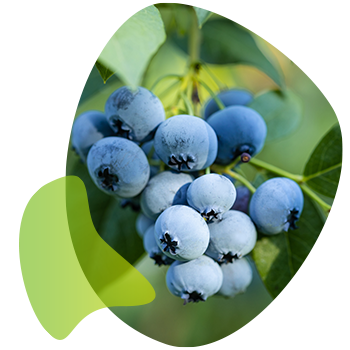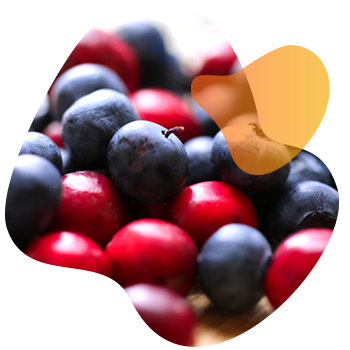Originally published : Mon, July 24, 2023 @ 9:06 AM
Every year over 1.5 million tonnes of blueberries and over half a million tonnes of cranberries are produced. This is expected to rise significantly over the coming years to meet ever-increasing global demand.1,2 In 2021, the USA was the world’s second-largest blueberry producer and the largest global cranberry producer.2,3 Both berries are well documented for their health benefits, but the DNA resources that would assist genetic studies and breeding improvements for these crops are limited.
The Vaccinium Coordinated Agricultural Project (VacCAP), which is funded by the United States Department of Agriculture’s National Institute of Food and Agriculture Speciality Crop Research Initiative (USDA-NIFA-SCRI) programme, is focused on addressing major bottlenecks limiting the growth of the US blueberry and cranberry industries by developing marker assisted selection (MAS) capacity in breeding programmes. The project is transdisciplinary in studying fruit quality traits by integrating genetics, genomics, plant physiology, socioeconomics and consumer sensory studies.
- Establish genomic resources to enable effective association mapping studies in blueberry and cranberry.
- Discover fruit characteristics and DNA markers that can help maximise and match industry profitability with consumer preferences in blueberry and cranberry.
- Deliver molecular and genetic resources to improve blueberry and cranberry fruit quality traits that maximise and match industry profitability with consumer preferences.
- Assess the potential socioeconomic impact of blueberry and cranberry fruit quality improvements on market demand.
- Engage US Vaccinium breeders and stakeholder groups to accept and make use of advanced phenomics and genomics tools to build a more coordinated and efficient cultivar development system.
 Blueberry cultivars belong to the genus Vaccinium and section Cyanococcus. Vaccinium plants are geographically widespread and different species have a high density in different locations across North and South America, Southeast Asia, and the Andes. There are genera related to Vaccinium outside of Cyanococcus, including those found in remote parts of the South Pacific. However, the current level of science does not yet easily allow combining genetics of Cyanococcus with non-Cyanococcus plants.4 Blueberries have a highly heterozygous complex genome.
Blueberry cultivars belong to the genus Vaccinium and section Cyanococcus. Vaccinium plants are geographically widespread and different species have a high density in different locations across North and South America, Southeast Asia, and the Andes. There are genera related to Vaccinium outside of Cyanococcus, including those found in remote parts of the South Pacific. However, the current level of science does not yet easily allow combining genetics of Cyanococcus with non-Cyanococcus plants.4 Blueberries have a highly heterozygous complex genome.Vaccinium macrocarpon is a diploid and one of the few crops that can be found growing in the wild in a wide variety of wetlands, mineral soils and moss lawns.6 Its wild relative Vaccinium oxycoccos L. (small cranberry) can be found as a diploid, tetraploid or, rarely, hexaploid, which only grows in peatlands.7 The small cranberry has a northern circumboreal distribution making it an interesting source of traits, including cold hardiness.6 Increasing global temperatures are likely to have a negative impact on cranberry yields, fruit quality and disease resistance, as these traits are known to be affected by heat stress.7
|
Why cranberries and blueberries?
“Blueberry and cranberry are perennial crops, and breeding cultivars using traditional methods is a time-consuming process. Marker assisted selection (MAS) represents an opportunity to accelerate the process and combine multiple traits. However, DNA-based resources for these two crops are limited.”
How did you select the lines to sequence to cover the diversity?
“We used Principal Component Analysis of diversity data and pedigree information to identify representative accessions to sequence.”
With SNP markers in hand, what traits are being looked at as beneficial, advantageous and desirable?
“In the VacCAP project we are targeting desirable levels of many traits including: texture/firmness and chemistry (volatiles and non-volatiles), which affect sensory perception like sweetness and acidity but can also extend shelf life and reduce fruit damage during mechanical harvest.”
What unique challenges do cranberry and blueberry have in terms of their genome genetics?
“The majority of cultivated blueberries are tetraploid, and some are hexaploid. As a diploid, cranberry has a less complex genome, but is highly heterozygous like blueberry, which brings a different level of genome complexity.”
What criteria were used to compare different platforms and how did Flex-Seq meet those?
“Flex-Seq was selected because it is flexible and the content of each panel can be modified without a large initial investment. Dosage can be estimated for the cultivated tetraploid blueberry. SNP, as well as haplotype data, can be generated. The same panel can be used across different programs. It is relatively cost-efficient for genome wide association studies.”
|
- Interrogate the SNP catalogue
- Deliver high SNP recovery
- Provide accurate genotyping
- Be flexible
- Offer reproducible genotype calling
- Be cost-effective
- Generate dosage and haplotype in the tetraploid cultivated blueberry
 The cranberry SNP catalogue was developed by Dr Ping Zhang at Washington State University. This included de novo SNPs from the 12 cranberry accessions that were sequenced and 8 SNPs that were associated with traits of interest from the association mapping done by Dr Juan Zalapa (co-PI on the project). Core genes, associated genes and trait-associated SNPs were then prioritised.
The cranberry SNP catalogue was developed by Dr Ping Zhang at Washington State University. This included de novo SNPs from the 12 cranberry accessions that were sequenced and 8 SNPs that were associated with traits of interest from the association mapping done by Dr Juan Zalapa (co-PI on the project). Core genes, associated genes and trait-associated SNPs were then prioritised.- It is a two probe hybridization based approach
- It generates 200-300 base pairs sequences, including target group and variations in that region.
- The process is easy: The research team collects the leaf samples and LGC Biosearch Technologies performs the DNA extraction as well as the genotyping and sends the data back to the team.
- The volume ordering is cost-effective.
Our scientific team is available to collaborate with you to achieve your genotyping goals. You can email us at techsupport@biosearchtech.com.
- Watch the webinar with Dr Leandro Neves on targeted high throughput SNP and haplotype genotyping with Flex-Seq.
- Find out how scientists at the Kazusa DNA Research Institute overcame the challenge of the strawberry’s complex genome.
- Download our case study on addressing the challenges of large scale genotyping for complex genomes.


